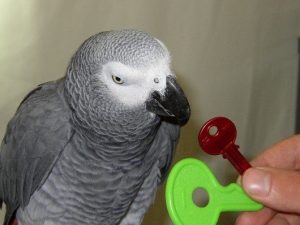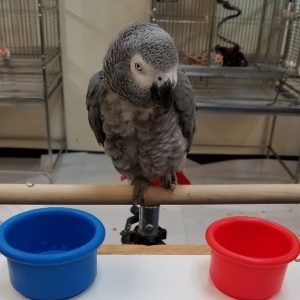Contents

I’m often asked in interviews if my parrots really know what they are saying. My usual response is to provide solid scientific evidence that they couldn’t answer correctly otherwise. I might describe how I used to show Alex, and now can show Griffin, a particular object, and how each bird would correctly respond to several questions about it—for example, “Blue” to “What color?”, “Four-corner” to “What shape?”, “Wood” to “What matter?” and “Block” to “What toy?”
Or, for Alex, who also knew concepts of same/different, I would relate how I could show him, for example, two keys, one green and one red, and ask, “What’s different?” to which he’d reply, “Color”, then “What color bigger?” and he’d give the correct color, and finally I could ask “How many?” and he would state “Two.” Both birds had to be able to recognize the correspondence between each label and each of the separate questions in order to make each appropriate response, even though all their responses were to the same objects—the objects themselves obviously could not be a simple cue to say one particular thing. Sometimes, however, I wish I could have used some anecdotal evidence instead, because the anecdotes, although not very scientific, are a lot more fun to relate.
When a Parrot’s Use of Words is Very Clever, But….
One example occurred awhile back when Griffin did not want to climb [get on a human hand] for one of the students. This particular student is terrific; however, he happens to be working on a project that Griffin does not like very much. Thus, whenever the student asks Griffin to “Climb,” Griffin figures that he’s going to be made to work on this difficult task. The other day, the student asked several times, and each time Griffin put his head down, gave the student the famous Grey parrot slitty-eye’ look, and refused with his squeaky “Nuh.” The student persisted. Finally, Griffin walked to the other side of his cage, looked directly at a different student, put his foot up, and very, very clearly said “Come here!”
Then there was the time that Alex kept stating “Want grape,” but then also kept refusing the lovely green one that the student was offering. Finally, he gave her a look that could only be interpreted as frustrated, and belted out “urp-ul”…the utterance that, at the time, he was using for the label purple. She got the message, and I had to go to the grocery store the next morning for the appropriate item.
Another time, Alex stated “Want corn,” and this time the student wanted him to give the color. She kept asking “What color?” and he kept stating, over and over, “Want corn!” Finally, he looked her right in the eye and told her “I’m gonna go away”… and turned around and walked to the back top of his cage! That particular incident was caught on tape, as the BBC was filming the whole interaction.
 Recently, Griffin very deliberately misunderstood a student. The student was working on a task in which Griffin had to respond with the color of either the bigger or smaller of two cups, depending on the question the student posed. The answer in this case was “Rose,” and Griffin mumbled it pretty badly. He, however, figured he was correct, and immediately said “Wanna nut” to get his reward. The student wasn’t going to let him get away with a mumbled answer, so she said “You’re right, but talk clearly…say better.” To which Griffin replied “Want.a.nut!” with perfect diction! It was quite difficult not to reward this behavior with a laugh.
Recently, Griffin very deliberately misunderstood a student. The student was working on a task in which Griffin had to respond with the color of either the bigger or smaller of two cups, depending on the question the student posed. The answer in this case was “Rose,” and Griffin mumbled it pretty badly. He, however, figured he was correct, and immediately said “Wanna nut” to get his reward. The student wasn’t going to let him get away with a mumbled answer, so she said “You’re right, but talk clearly…say better.” To which Griffin replied “Want.a.nut!” with perfect diction! It was quite difficult not to reward this behavior with a laugh.
Clearly, the anecdotes represent single incidents, incidents that we can’t reproduce in order to get statistical significance—the gold standard of any scientific research. I can’t present these anecdotes in a scientific report or a conference presentation; my colleagues would—rightfully—argue that these instances could have happened by chance, given all the hours of interactions between humans and birds in my laboratory. I believe, however, that these anecdotes provide interesting insights into how the mind of a parrot may work. And, sometimes, anecdotes can inspire the design of our scientific studies, as when we decided to study addition after Alex gave some evidence that he was summing the number of clicks that we were using to train Griffin on numerical concepts (see Pepperberg, 2006).






Fantastic! Let’s keep learning about these wonderful, amazing creatures.
Dr. Pepperburg this study is so amazing, but it’s ashamed the anecdotes won’t be accepted into the study after so much hard work. I can identify with some of the antics Griffin uses, my AGCP does similar actions and makes wise remarks, although not so much as Alex did and Griffin does. Continue on.